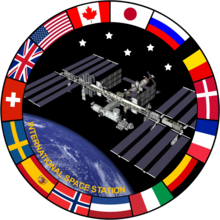
Back برنامج محطة الفضاء الدولية Arabic پروژه ایستگاه فضایی بینالمللی Persian Programma della stazione spaziale internazionale Italian
This article needs to be updated. (July 2022) |
 Insignia with flags of the original signatory states. | |
| Program overview | |
|---|---|
| Organisation | |
| Manager |
|
| Status | Active |
| Programme history | |
| Cost | $150 billion (2010) |
| Duration | 1993–present[2] |
| First flight | Zarya November 20, 1998 |
| First crewed flight | STS-88 December 4, 1998 |
| Launch site(s) |
|
| Vehicle information | |
| Uncrewed vehicle(s) | |
| Crewed vehicle(s) |
|
| Crew capacity |
|
| Launch vehicle(s) | |
| Part of a series on the |
| United States space program |
|---|
  |
The International Space Station programme is tied together by a complex set of legal, political and financial agreements between the fifteen nations involved in the project, governing ownership of the various components, rights to crewing and utilisation, and responsibilities for crew rotation and resupply of the International Space Station. It was conceived in September 1993 by the United States and Russia after 1980s plans for separate American (Freedom) and Soviet (Mir-2) space stations failed due to budgetary reasons.[2] These agreements tie together the five space agencies and their respective International Space Station programmes and govern how they interact with each other on a daily basis to maintain station operations, from traffic control of spacecraft to and from the station, to utilisation of space and crew time. In March 2010, the International Space Station Program Managers from each of the five partner agencies were presented with Aviation Week's Laureate Award in the Space category,[3] and the ISS programme was awarded the 2009 Collier Trophy.
- ^ Harbaugh, Jennifer (August 19, 2015). "August 19, 2015". NASA. Retrieved September 27, 2020.
- ^ a b Holmes, Steven A (September 3, 1993). "US And Russians Join in new plan for Space Station". The New York Times. Retrieved October 3, 2022.
- ^ "India space station India plans to launch space station by 2030 Space Station". October 18, 2019. Archived from the original on October 19, 2019.
© MMXXIII Rich X Search. We shall prevail. All rights reserved. Rich X Search